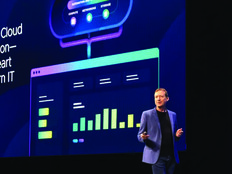Collaborating in the Cloud
IT modernization often involves application rationalization that may result in migrating resources to the cloud. This can quickly result in improved user experiences: Robust cloud services scaled to an appropriate size can give everyone what they need upon demand to get the job done. As the white paper notes, cloud tools can “foster interagency interoperability, centralizing communications and facilitating real-time coordination by enabling fast, streamlined information sharing.”
Replatforming applications also can tremendously improve security. Software as a Service solutions receive automatic security updates from major cloud service providers, clearing requirements to upgrade or patch applications.
Adopting cloud solutions also streamlines security management by centralizing an application portfolio and ensures business continuity by simplifying backup and recovery. Government IT admins may also reduce their agencies’ attack surface by synchronizing solutions through the cloud across multiple branches.
Standardizing Experiences for Workspace Modernization
Of course, cloud adoption often optimizes the experience of government employees. Employees using the same agile, scalable solutions across a large enterprise can collaborate seamlessly while enjoying the benefits of a smooth interface. Standardizing solutions for workspace modernization may shrink the number of applications in use, further reducing the agency’s attack surface.
“Streamlining can help reduce costs and enhance security by limiting the number of products that must be patched, maintained and monitored,” states the CDW white paper.
With simplified security management, government IT admins must enforce fewer security protocols, applying standard security policies consistently across specific cloud solutions. Standardized configurations and policies also increase visibility into the government IT environment, improving asset management.
Improved collaboration also boosts security awareness, as smooth communications throughout a unified enterprise ensures all employees are on the same page and not operating in communications silos where they may not receive all of the information they need to operate safely.
Using Automated Tools to Handle Routine Tasks
For the past few years, agencies have closely studied artificial intelligence as a means to enhance both productivity and security. Government organizations are still weighing the best options for using AI solutions at scale, but many have agreed on some common use cases. For example, many agencies use AI chatbots to handle initial public inquiries. This gives time back to employees with a lot to do.
“Automated tools can handle routine inquiries and enable workers to focus on the most critical calls,” notes the CDW white paper.
Through automation, government IT admins can also reduce human error, speed threat detection and response, and enforce consistent security policies across their environments.
Click the banner below for the latest federal IT and cybersecurity insights.
Migrating to the Cloud for Security
Each of these optimization measures may result in migrating resources to the cloud. Often, that will impart significant security improvements to an office environment.
Agencies can benefit from cloud-native security features, including encryption, multifactor authentication and intrusion detection. Cloud service providers also offer the latest options in AI solutions, which can automate and augment threat detection and response. Cloud service providers may also automate patch management, vulnerability scanning and security monitoring. They can scale security features as required across a government IT enterprise.
And, of course, cloud migration significantly optimizes the digital experience for employees through consistent access and streamlined workflows, and a more productive workforce can also be a more secure workforce.














